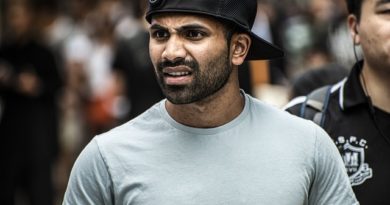Building Bigger Biceps: Training Guide to Perfect Your Pythons
Let’s face it – everyone wants bigger “guns.” Walking around with water-pistols isn’t going to turn heads. You want the size, you want the peak… so what’s holding you back? Genetics? To a degree. Specific biceps workout for growth? Good possibility! I have good news, and I have bad news when it comes to building bigger biceps.
Let’s start with the bad news because I think the good news will outweigh the bad. Bad news is that you can’t change your genetics. If you have short muscle belly’s or long muscle belly’s that isn’t going to change at all no matter how hard you try. Those are genetics and you are either blessed or screwed.
If you are screwed, here comes the good news for building bigger biceps. There are workouts to at least help you put on some nice size gains and add some peak to your biceps. Read through this article and you will be on your way to understanding how to make those pythons dangerous.
I first want to share with you something I wrote a while back on building bigger biceps to help you first understand the anatomy of the muscle itself. That way you at least are learning a little bit about the human body since you are working on perfecting it.

Disclaimer: This article is for informational purposes only and is not meant to treat or diagnose any condition. It is recommended that you speak with your doctor before starting any exercise program, changing your daily nutrition, or adding any supplements to your regimen.
Why is Building Bigger Biceps Something Most Want to Achieve?
Building bigger biceps is a fitness goal that many people aspire to for several reasons:
- Aesthetics: Well-developed biceps contribute to the overall appearance of muscular and well-defined arms. Many individuals find that having larger biceps enhances their physical appearance, which can boost confidence and self-esteem.
- Symbol of Strength: Biceps are often seen as a symbol of strength. Having well-defined and muscular biceps can be a visual indicator of an individual’s physical prowess and fitness level.
- Cultural Influences: Popular culture, including movies, television, and media, often portrays individuals with muscular arms and prominent biceps as attractive and powerful. This cultural influence can contribute to the desire for bigger biceps.
- Social Comparison: People often compare themselves to others, whether in person or on social media. Seeing individuals with well-developed biceps can create a desire to achieve a similar physique.
- Fitness Goals: For many individuals engaged in weight training and bodybuilding, building bigger biceps is a specific fitness goal. It provides a measurable and tangible target for progress, making it a common objective in strength training programs.
- Functional Strength: While the primary function of biceps is to flex the elbow joint, they also play a role in various daily activities that involve lifting and pulling. Building bigger biceps can contribute to improved functional strength in these activities.
It’s important to note that while developing bigger biceps is a common fitness goal, a well-rounded and balanced approach to strength training is crucial for overall health and fitness. Focusing solely on one muscle group, such as the biceps, may lead to imbalances and increase the risk of injury. A comprehensive strength training program that targets all major muscle groups is recommended for optimal results and overall health.
Does Building Bigger Biceps Take a Lot of Work?
Building bigger biceps, like any fitness goal, requires consistent effort, dedication, and a well-structured training program. The amount of work it takes can vary depending on several factors, including your current fitness level, genetics, and how quickly your body responds to training. Here are some key considerations:
- Consistency: Consistency is crucial in any fitness endeavor. Regularly engaging in bicep-specific exercises and adhering to a consistent workout routine is essential for seeing progress.
- Intensity: Building muscle generally requires challenging your muscles with progressively heavier weights over time. This means gradually increasing the intensity of your bicep workouts by lifting heavier weights or performing more challenging exercises.
- Proper Form: Performing exercises with proper form is essential for targeting the biceps effectively and preventing injuries. Using correct form ensures that you are engaging the targeted muscles and not placing unnecessary strain on other parts of your body.
- Nutrition: A well-balanced diet that provides the necessary nutrients for muscle growth is crucial. Ensure you are consuming enough protein, as it is essential for muscle repair and growth. Additionally, adequate overall calorie intake is important for supporting your energy needs during workouts.
- Rest and Recovery: Building muscle doesn’t just happen during workouts; it also occurs during rest and recovery periods. Make sure to allow your biceps and the rest of your body sufficient time to recover between workouts.
- Genetics: Genetics can play a role in how quickly individuals see muscle growth. Some people may naturally have an easier time building muscle, while others may need to put in more effort.
It’s important to note that focusing solely on building bigger biceps might lead to imbalances. A well-rounded strength training program that targets all major muscle groups is recommended for overall health and balanced muscle development.
While building bigger biceps does require effort, the key is to find a sustainable and enjoyable approach to fitness. Work with a fitness professional or do research to create a workout plan that aligns with your goals and fits into your lifestyle. Additionally, listen to your body, and avoid overtraining, as this can hinder progress and increase the risk of injury.
Important Muscles to Learn When Building Bigger Biceps
Below are some of the key muscles you need to focus on when building bigger biceps:
Biceps Brachii
The biceps brachii is given the name biceps because it has two heads, and brachii comes from the Latin word for arm.
The short head of the biceps attaches to the coracoid process of the scapula. The tendon of the long head passes into the joint capsule at the head of the humerus and attaches on the scapula at the supraglenoid tubercle.
The biceps brachii is a muscle on the upper arm that acts to flex the elbow. Since the biceps is attached to the radial tuberosity, this bone can rotate which allows the biceps to also supinate the forearm.
Brachialis
It arises from the distal, anterior half of the humerus and the intermuscular septa. It inserts into the coronoid process and tuberosity of the ulna over the elbow joint.
The brachialis is the main flexor of the forearm.
Pronator Teres
It arises from the distal end of the medial humerus and the medial part of the ulna. From there it inserts into the lateral side of the radius.
The job of the pronator teres is to pronate at the forearm and to also flex the forearm at the elbow.
Biceps Exercises
If bicep size is what you want then you can’t go wrong with the straight barbell curl. That exercise needs to be a staple in your biceps training. Load up the weight (maintain good form) and hit it hard. If you find the straight barbell causes some wrist pain, simply switch out the straight bar with the EZ bar which will put your wrists in a more natural position.
Workouts
The key to building bigger biceps is to incorporate a variety of exercises to hit the muscle different ways. You always want to keep the muscle guessing because just like everything else, your muscles will adapt to a certain workout or exercise and will not stimulate the fibers in a way that will make them want to grow.
You always want to start off your biceps workout with a heavy movement like the barbell curl. Early in your workout you are fresh and can handle a little heavier workload when compared to later on in the workout when your muscles are fatigued and the lactic acid build-up is more prevalent. At that point you can do some cable bicep work.
Everyone is different when it comes to results from training protocols. Some people respond better to high volume training, some don’t. Some people respond better in a rep range between 8-10, some find better results from 12-15.
RELATED: Can You Build Mass Using At-Home Workouts for Biceps?
What I’m getting at is I do not have the answer for you in terms of getting you the results you so desire without working with you one-on-one and getting to know how your body reacts to the training styles. With that being said, figuring out what works best for you is half the battle and half the fun. If everyone responded the same way, we would all be cutting off our shirt sleeves, but look around!
Figuring Out What Works For You Is Half The Battle
Obviously others haven’t figured it out either. So below you will find many different workouts that you can try out and see how you respond.
Try anywhere from 3-5 sets of each exercise with the reps between 8-15. Keep mixing it up to see how your muscles recover and grow. It’s ok to be a little sore the next day, shows you worked the muscle. Afterwards it’s time to feed and rest the muscle. All those things considered, the next thing to happen is growth.


*Disclosure: This article may contain affiliate links or ads, which means we earn a small commission at no extra cost to you if you make a purchase through these links. These commissions help support the operation and maintenance of our website, allowing us to continue producing free valuable content. Your support is genuinely appreciated, whether you choose to use our links or not. Thank you for being a part of our community and enjoying our content.
PLEASE CONSIDER SHARING THIS ON YOUR SOCIAL MEDIA TO HELP OTHERS LEARN MORE ABOUT THIS TOPIC.





